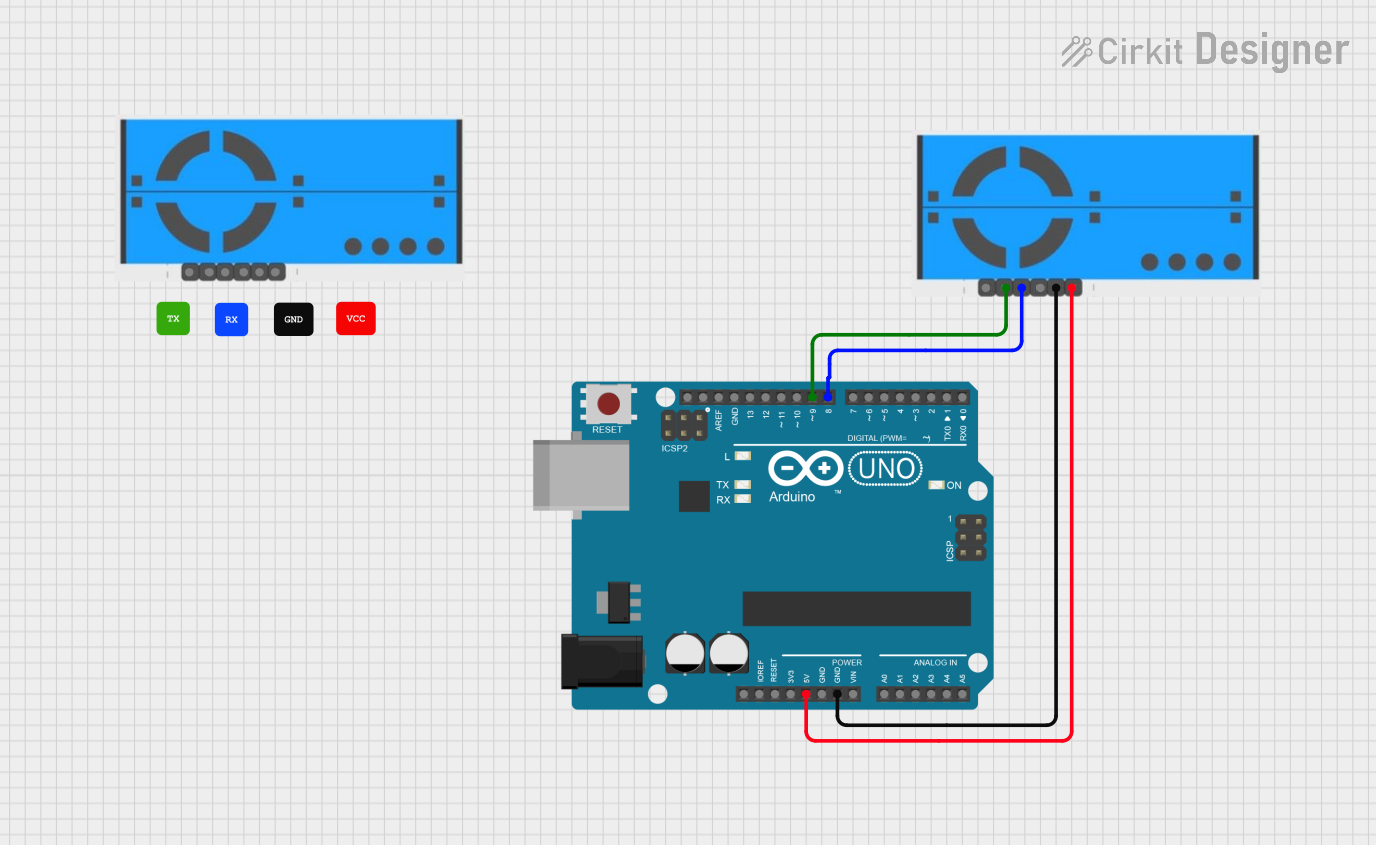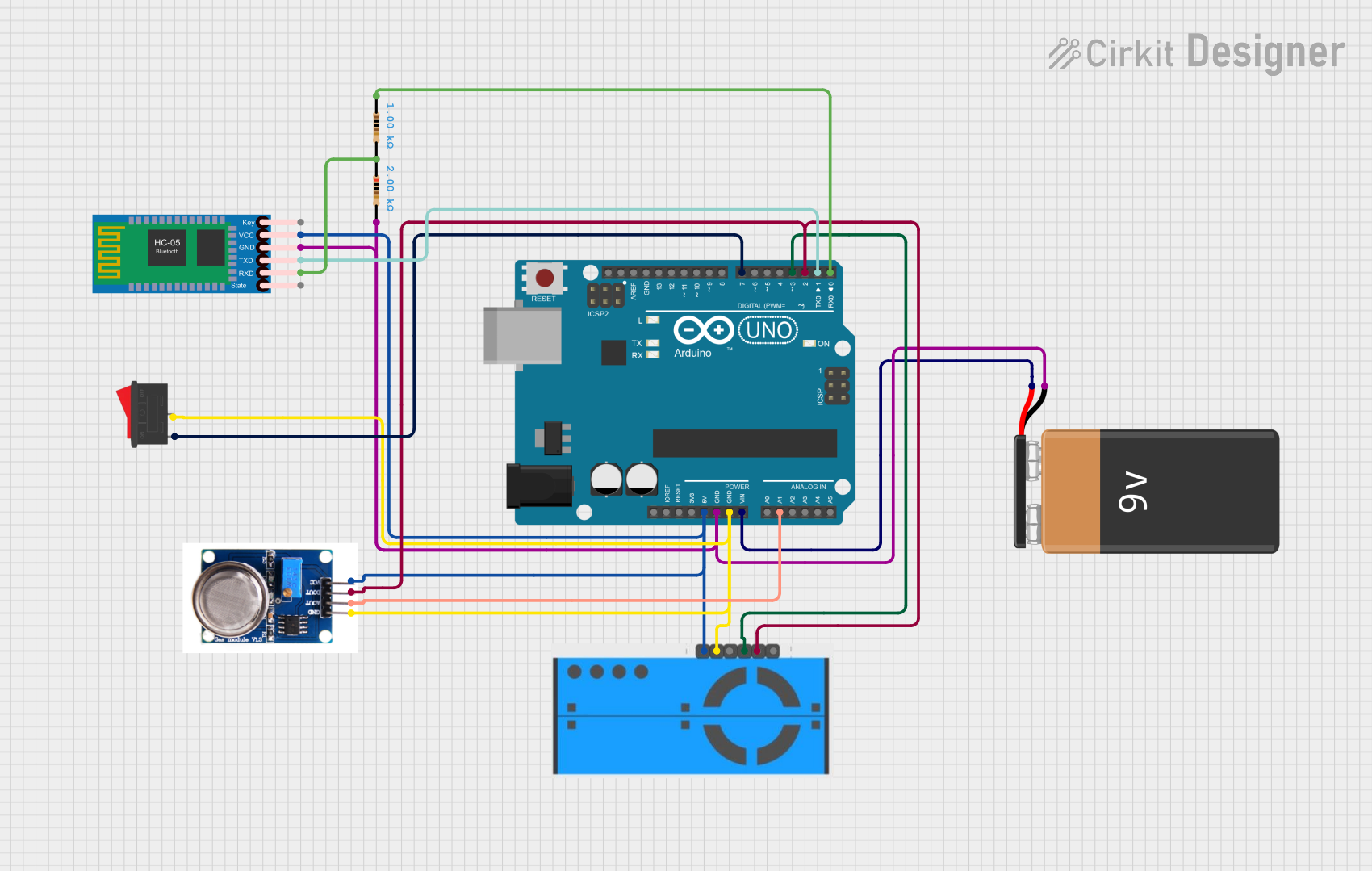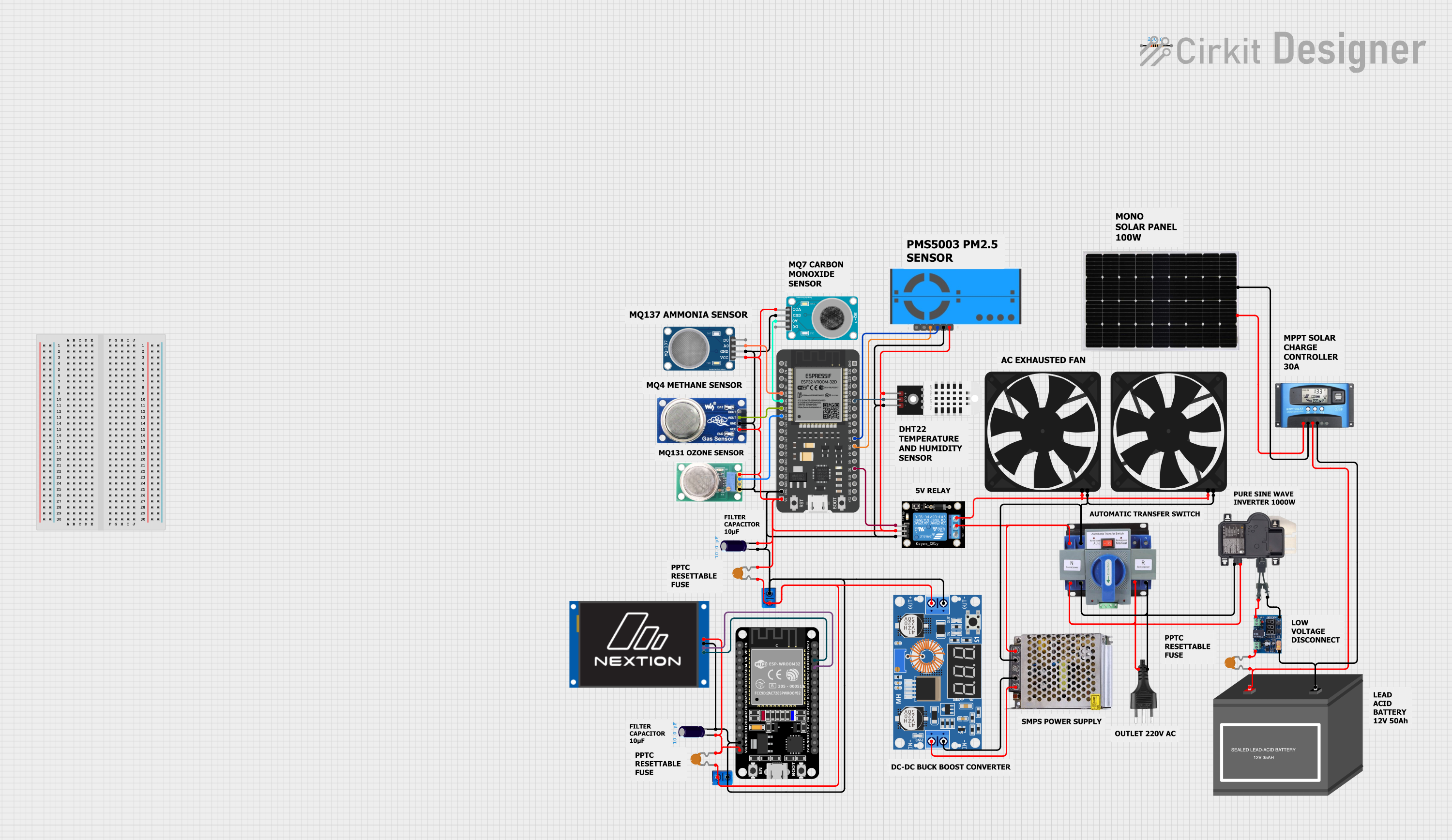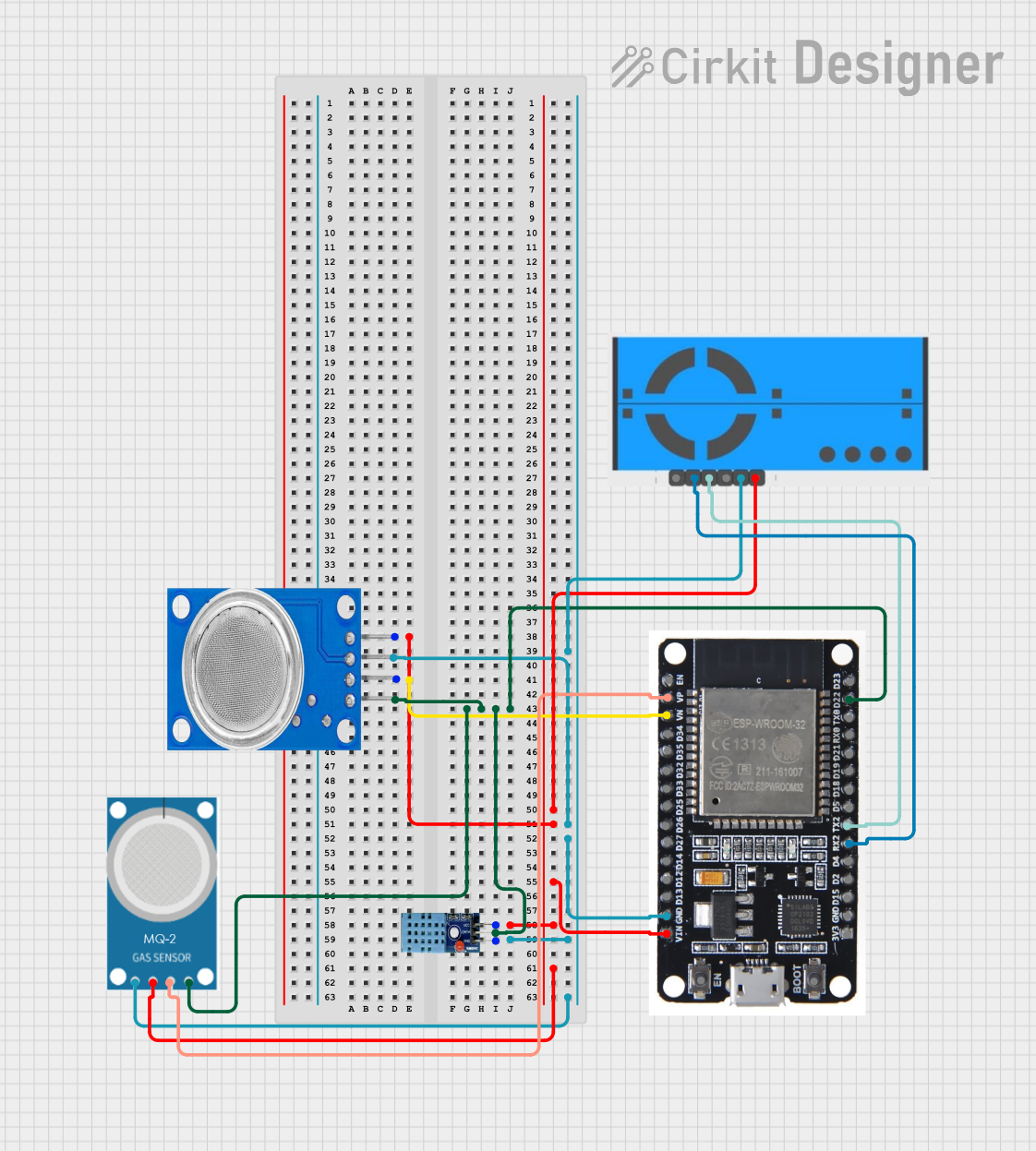
How to Use PM2.5 Air Quality Sensor and Breadboard Adapter Kit - PMS5003: Examples, Pinouts, and Specs

 Design with PM2.5 Air Quality Sensor and Breadboard Adapter Kit - PMS5003 in Cirkit Designer
Design with PM2.5 Air Quality Sensor and Breadboard Adapter Kit - PMS5003 in Cirkit DesignerIntroduction
The PM2.5 Air Quality Sensor with Breadboard Adapter Kit (Adafruit Part ID: 3686) is an advanced sensor designed to measure fine particulate matter in the air, specifically particles that have a diameter of less than 2.5 micrometers (PM2.5). These particles are considered hazardous as they can penetrate deep into the human respiratory system and cause health issues. The PMS5003 sensor is commonly used in air quality monitoring devices, environmental monitoring stations, and HVAC systems to ensure air quality is within safe limits.
Explore Projects Built with PM2.5 Air Quality Sensor and Breadboard Adapter Kit - PMS5003

 Open Project in Cirkit Designer
Open Project in Cirkit Designer
 Open Project in Cirkit Designer
Open Project in Cirkit Designer
 Open Project in Cirkit Designer
Open Project in Cirkit Designer
 Open Project in Cirkit Designer
Open Project in Cirkit DesignerExplore Projects Built with PM2.5 Air Quality Sensor and Breadboard Adapter Kit - PMS5003

 Open Project in Cirkit Designer
Open Project in Cirkit Designer
 Open Project in Cirkit Designer
Open Project in Cirkit Designer
 Open Project in Cirkit Designer
Open Project in Cirkit Designer
 Open Project in Cirkit Designer
Open Project in Cirkit DesignerTechnical Specifications
Key Technical Details
- Measuring Range (PM2.5): 0 to 500 µg/m³
- Resolution: 1 µg/m³
- Maximum Operating Voltage: 5V DC
- Maximum Operating Current: 100 mA
- Standby Current: ≤200 µA
- Operating Temperature: -10 to 60°C
- Operating Humidity: 0 to 99% RH
Pin Configuration and Descriptions
| Pin Number | Name | Description |
|---|---|---|
| 1 | VCC | Power supply (4.5V-5.5V) |
| 2 | GND | Ground connection |
| 3 | SET | Set pin (active low) |
| 4 | RX | UART receive pin |
| 5 | TX | UART transmit pin |
| 6 | RESET | Reset pin (active low) |
| 7 | NC | Not connected |
| 8 | NC | Not connected |
Usage Instructions
Interfacing with a Circuit
To use the PMS5003 sensor with a development board like the Arduino UNO, follow these steps:
- Connect the VCC pin to the 5V output on the Arduino.
- Connect the GND pin to one of the GND pins on the Arduino.
- Connect the TX pin of the sensor to a digital pin on the Arduino configured as RX (for software serial communication).
- Connect the RX pin of the sensor to a digital pin on the Arduino configured as TX (for software serial communication).
- The SET and RESET pins can be left unconnected if you wish the sensor to run continuously.
Important Considerations and Best Practices
- Ensure that the power supply is stable and within the specified voltage range.
- Avoid exposing the sensor to high concentrations of organic solvents, corrosive gases, or dust.
- Allow the sensor to preheat for at least 30 seconds to stabilize readings.
- Use a software serial library to communicate with the sensor if the hardware UART is unavailable.
Example Code for Arduino UNO
#include <SoftwareSerial.h>
SoftwareSerial pmsSerial(10, 11); // RX, TX
void setup() {
Serial.begin(9600);
pmsSerial.begin(9600);
}
void loop() {
if (pmsSerial.available()) {
// Read data from the sensor
uint8_t buffer[32];
int index = 0;
while (pmsSerial.available() && index < 32) {
buffer[index++] = pmsSerial.read();
}
// Process the data (assuming the data starts with 0x42 0x4d)
if (index == 32 && buffer[0] == 0x42 && buffer[1] == 0x4D) {
int pm25 = (buffer[12] << 8) + buffer[13];
Serial.print("PM2.5: ");
Serial.print(pm25);
Serial.println(" ug/m3");
}
}
}
Troubleshooting and FAQs
Common Issues
- Inaccurate Readings: Ensure the sensor has preheated and is not exposed to volatile organic compounds or other pollutants that could affect the readings.
- No Data: Check the wiring, especially the RX and TX connections. Ensure the sensor is powered correctly.
- Sensor Not Responding: Try resetting the sensor or checking the SET pin if connected.
Solutions and Tips for Troubleshooting
- Preheating: Allow the sensor to preheat for at least 30 seconds before taking readings.
- Wiring Check: Double-check the wiring against the pin configuration table.
- Serial Communication: Ensure that the baud rate for serial communication matches the sensor's default rate (9600 bps).
FAQs
Q: Can the sensor be used outdoors? A: Yes, but it should be protected from direct sunlight, rain, and condensation.
Q: How often should the sensor be calibrated? A: The PMS5003 sensor is factory-calibrated and typically does not require additional calibration.
Q: What is the lifespan of the sensor? A: The sensor has a lifespan of approximately 3 years when used as recommended.
Q: Can I use multiple PMS5003 sensors with one Arduino? A: Yes, but each sensor will require a separate software serial port, or you can use a multiplexer for the UART lines.